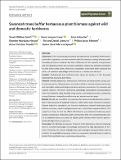| dc.description.abstract | Questions: Given the growing abundance and dominance of domestic herbivores in
savannah ecosystems, can trees maintain plant herbaceous standing biomass under
increasing herbivore pressure? Are there differences in the capacity of leguminous
and non-leguminous trees in sustaining understory herbaceous biomass? And finally,
to what extent does plant community composition underneath trees modulate the
effects of herbivore assemblage and abundance on herbaceous biomass?
Location: Pasturelands and protected areas along the borders of the Serengeti
National Park, Tanzania, East Africa.
Method: Monthly herbaceous biomass was monitored non-destructively using a calibrated pasture disc. Measurements were taken within a network of paired exclosures
and open plots, underneath large leguminous and non-leguminous tree canopies and
outside canopies. Herbivore community assemblage compositions and abundances
were characterised using monthly dung counts, and herbaceous plant community
composition was surveyed annually every wet season over two years.
Results: Overall, we found that trees promote herbaceous standing biomass, particularly in the presence of moderate herbivory rather than under herbivore exclusion.
Greater herbivore abundance and livestock dominance reduced herbaceous plant
biomass, but trees, particularly leguminous trees, limited these negative effects. This
capacity for trees to limit the effect of herbivores was related to herbaceous plant
species composition. Understory plant communities that were compositionally typical of protected areas sustained the highest plant biomass when found in pasturelands with high herbivore pressure.
Conclusion: Our findings give greater credence to the importance of preserving large
trees in savannah landscapes increasingly dominated by high abundances of livestock. Moreover, our results highlight that park managers and pastoralists need to
maintain the specialist herbaceous understory community beneath trees in order to
benefit from facilitative tree–understory interactions. | en_US |

